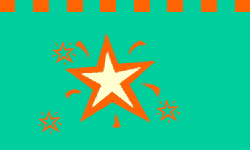In the first few years of teaching I spent much of the first part of the year making sure that my students
knew the alphabet. It seemed to be so easy for some kids and so difficult for others. For those that were visual
learners, remembering the letter shapes was no problem. For those that were auditory learners, remembering the letter
sounds was no problem. But my classroom was a mixture of students with different learning preferences and different
background experiences with text. And drill and practice with flashcards seemed so disconnected from the type of active
learning I preferred. How could I help such different students and make the experience fun?
I first heard about a program called "Jolly Phonics" through a parent of one of my students who worked at
an elementary school that used the program. She mentioned that it paired each letter of the alphabet with an action
to help students remember it and the sound that it made. I was interested in seeing whether something like this would
work with my students, but I felt that something was missing. As a visual learner myself, I wanted to also include a
visual element. So I began playing around and trying to think of words and actions that made sense with each letter
and could also be paired with something the students would recognize visually no matter what their prior background.
The result was a simple alphabet in which each letter had been drawn to include a visual clue that would
trigger the student to remember the letter sound and/or accompanying action. I introduced all of the letters briefly
at the beginning of the year at the pace of three letters a day so that everyone had some understanding and would be able
to use the cues to help them in their writing and in reading words. We reviewed the letter flashcards each day and said
the letter name and the sound while we did the action. Then we studied each letter more in-depth throughout the rest
of the year.
I found that my students learned the letter names and their sounds much more quickly this way, and that
it made the task of writing more accessible to them. They no longer had to look at a plain looking alphabet strip and
try to figure out which letter said /t/ by starting at A and going through each picture until they found one that started
with that sound (in fact, for many of my students, this was nearly impossible, as they did not have the phonological awareness
skills to isolate the beginning sound of a word). Instead, if they needed to know what letter said /t/, they said the
sound and let their body do the motion that had become a habit to do simultaneously with the sound. Then they could
look at the letters and remember which picture was a cue for that action.
Since parents were unfamiliar with this approach, I made flash cards of the letters and sent them home for
the parents to use with the child. The children were already familiar with the motions and the parents could prompt
them on the sounds if they got stuck. I also sent home a list of action cues to help parents to prompt the kids if they
forgot. This information was available via the class website if parents misplaced their "cheat sheet".
I found that integrating visual cues with auditory and kinesthetic learning increased the fun my students
had in learning the letter sounds, and improved their retention of the letter names and sounds. It also helped
them in their writing and in beginning to decode short words.

